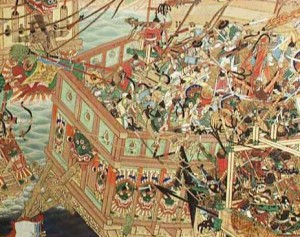Mystery Chinese Weapon from 1277 November 7, 2010
Author: Beach Combing | in : Medieval , trackback Beachcombing recently came across this extraordinary passage from the Chinese Sung Shih. In 1277 Lou Ch’ien-Hsia was besieging a fortification held by two hundred and fifty defenders. Frustrated, Lou Ch’ien-Hsia ordered his men to bring up a huo p’ao – a word Beachcombing will come back to.
Beachcombing recently came across this extraordinary passage from the Chinese Sung Shih. In 1277 Lou Ch’ien-Hsia was besieging a fortification held by two hundred and fifty defenders. Frustrated, Lou Ch’ien-Hsia ordered his men to bring up a huo p’ao – a word Beachcombing will come back to.
‘He lit the huo p’ao and a clap of thunder was heard, the walls crumbled, and smoke covered the sky. Many soldiers outside died of fright. When the fire went out, they went inside and failed to find even the ashes of the 250 defenders; they had disappeared without trace.’
The huo p’ao should be a ‘fire bundle’, often applied to a trebuchet hurling incendiary devices. Though that doesn’t even begin to account for what is being described here: something that would be more suited to black magic or machinery kept in the crate of a thirty-first-century space ship.
WANW J.R.Partington (250) suggests that we are dealing with chen t’ien lei, a thunder-shaking-the-sky, essentially an early Chinese bomb with shrapnel and explosives in a large cauldron-shaped object.
This would not be very surprising as the Chinese were innovative in the field, particularly in this period. Indeed, ‘[b]y A.D. 1000 at least ‘explosive grenades’ and ‘bombs’ were being fired from catapults. By A.D. 1040 (or 1044) the Wu Ching Tsung Yao ‘stabilised the Chinese name for gunpowder (huo yao) and registered an extremely rapid development of projectile weapons, poisonous and signalling smokes, flame-throwers and other novel inventions’’. (261)
And chen t’ien lei were certainly used in the thirteenth and fourteenth centuries. One extraordinary account has a thunder-shaking-the-sky bomb lowered from city walls on top of besieging Mongol soldiers who had protected themselves with large oxhide shields. ‘When [this bomb] reached the place where [the Mongols] were digging, fire burst forth, and the men and the oxhides were all broken to fragments flying in all directions so that no trace was left’.
However, even that doesn’t get us much closer to explaining what happened in 1277 when there were city walls protecting the two hundred and fifty men.
So how do we account for the disappearance of the garrison?
Well, Partington gets a little shirty with his source and writes ‘This is obviously an exaggeration (the effect is impossible)…’
It certainly is an exaggeration with any technology known today and, while Beachcombing is most impressed by what the medieval Chinese achieved, he’s not about to credit them with science-fiction like powers. Perhaps Partington is right. Perhaps the translation is wrong. Any ideas? drbeachcombing AT yahoo DOT com
***
Dec 1, 2010: Beachcombing got a dozen emails about this. First sinologist Vincent Leung was kind enough to confirm that, to the best of his knowledge – this is not his area of expertise – the Sung Shi has not yet been translated into a European language, which rather hamstrings all Beachcombing’s efforts to confirm the sentence that he quoted from Partington. Mandarin classes anyone… However, if we take for a given that the translation that Beachcombing gave is correct then an explanation might be in sight. The following comes from Leslie: ‘It may be better to wonder about the architecture of the Chinese garrison and not the nature of the incendiary device. The translation you give states that the 250 men were holed up in a garrison, not a city. Is it possible the garrison had mud brick walls or even wooden walls? If the device landed in the middle of a wooden structure, such as a hay filled stable or houses with thatched roofs, then the explosion would have started a large, hot fire that would have quickly swept through the structure destroying everything even causing the brick walls to collapse. Asking a fireman might provide a more satisfactory answer to the riddle than trying to guess at the nature of the bomb.’ Graham meanwhile reflected on the technology: ‘I read your post about this ancient Chinese weapon, and what came to mind was the thought that perhaps the device was an accelerated fuel air explosive. Fuel air explosions have the sort of destructive power attributed to the weapon in question; some form of volatile liquid with iron filings or similar surrounding a charge would be quite nasty. A correctly detonated, modern fuel-air/thermo-baric ordnance has the flattening power of a small nuke. The Chinese were experimenting with gunpowder and numerous variants, creating rockets, fireworks and weapons, this could have been just part and parcel of the technology extant at that time.’ Thanks awfully to Vincent for the background and Leslie and Graham for their insights!


